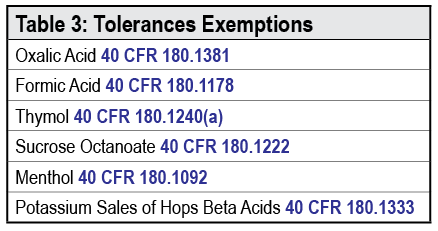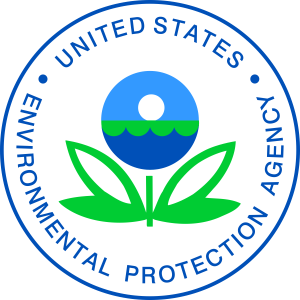 Study Hall – From the Editor
Study Hall – From the Editor
By: Jerry Hayes
Honey bees continue to struggle with pests, parasites and disease. Varroa and the varroa/Virus Complex is the main challenge for honey bees as it results in their overall loss of health, strength and vitality. We beekeepers have to be informed, connected and responsive to how we can be better honey bee managers.
Protecting our bees and ourselves from various varroa control products that may be offered or sold that may not have appropriate registration, labeling and oversight is a continuing awkward situation for us.
The managed honey bee beekeeping industry at all levels appreciate EPA’s recognition that varroa mites and the viruses they vector are an unresolved, serious threat to honey bee health. If left untreated colonies die as data shows. We can’t allow this to continue.
Our industry recognizes EPA’s awareness of the value of honey bees and its willingness to work with USDA and various partners.
There has been years of research on varroa control. But, the number of products continues to decline as varroa develops resistance.
The recently released advisory is designed to provide clarity regarding registered and unregistered products.
Beekeepers here in the U.S. and globally continue to consistently experience significant colony losses and many times are unable to financially recoup these losses.
This is a national threat which the government realizes and is working with many to identify solutions. We as an industry are in desperate need of solutions.
The EPA has indicated a willingness to ‘fast-track’ registrations of varroa control products. But, there are not many incentives for an applicant in our small industry to get a return on investment.
So, let’s kick the question back to EPA and USDA as to what is next?
Jerry
EPA is issuing this advisory to clarify what pesticide products and active ingredients are registered under Federal Insecticide, Fungicide and Rodenticide Act (FIFRA) to control varroa mites (Varroa destructor) in beehives, what tolerances or exemptions under Federal Food, Drug and Cosmetic Act (FFDCA) are applicable, and how the Agency views use of unregistered products to treat beehives for one’s own personal use. EPA is also affirming that use of registered pesticides must comply with FIFRA labeling requirements, that pesticide residues in honey must comply with any federal tolerances under FFDCA, and that states may have more restrictive requirements that must be followed as well.
It is a violation of FIFRA if a person uses registered pesticides in a manner that is not in accordance with label instructions. Currently, EPA has registered 16 pesticide products, covering about 10 active ingredients, that can be used on beehives to control varroa mites. In registering these pesticides products, EPA has conducted comprehensive evaluations and determined the products will not cause unreasonable adverse effects to human health or the environment. Using unregistered pesticides could result in a violation of FFDCA, if there are residues in the honey or other edible bee products (e.g., honeycomb, pollen) that are not covered by a tolerance or exemption under FFDCA. The sale or distribution of adulterated honey is a violation of FFDCA.
EPA remains committed to supporting the compliance and enforcement efforts by states with primary enforcement authority to ensure compliance with FIFRA requirements.
Why is EPA issuing an advisory now?
EPA has been made aware that beekeepers are using substances (e.g., oxalic acid, formic acid, amitraz and thymol) to control varroa mites in beehives. Although EPA understands that the substances being used—in the formulations in which they are being purchased—are not registered pesticides, the substances themselves are active ingredients in separately registered pesticide products.
EPA has been asked to clarify what pesticide products are registered for use to control varroa mites in beehives, if there are tolerances or exemptions that are applicable, and if it is a violation of FIFRA or FFDCA to use unregistered products on beehives for one’s own personal use. EPA believes it is unlikely that any operations offering products in commerce (e.g., bees/colonies, pollination services, honey or other beehive products) qualifies as a “own personal use.”
Additionally, as further discussed later, there are several EPA-registered formulations of these active ingredients (e.g., Apivar®, Apibioxal®; Mite-away Quick Strips [MAQS®], Formic Pro®; Apiguard®) approved for in-hive use with appropriate tolerance regulations.
What are varroa mites and why are they such a concern for the beekeeping community?
Varroa mites are parasites that feed on species of honey bees (Apis spp.), leading to reduced lifespan of the bees. They also transmit numerous honey bee viruses. The health of a colony can be critically damaged by an infestation of varroa mites. Once infested, if left untreated, the colony will likely die.
What does it mean to be a registered pesticide under FIFRA?
Any pesticide product that is not exempted from registration requirements cannot be lawfully sold or distributed unless it is registered. Before a pesticide is registered, EPA performs a rigorous, comprehensive scientific assessment of the product, resulting in a registration decision. Under this review, the Agency evaluates the product’s active ingredient(s), other constituent substances (including inert ingredients), and the proposed use pattern(s) to ensure that, when the product is used according to labeled directions, no unreasonable adverse effects on human health or the environment will occur. When EPA has determined that use of a pesticide product will not cause unreasonable adverse effects to human health or the environment, the Agency grants the applicant a license or “registration” to legally sell and distribute the product in the United States.
What does it mean to be exempt from the requirements of FIFRA as a “minimum risk pesticide”?
Because EPA has determined that certain “minimum risk pesticides” pose little to no risk to human health or the environment, EPA has exempted them from the requirement of registration under FIFRA. A minimum risk pesticide must meet all six conditions under 40 CFR 152.25(f) to be exempted from regulation under FIFRA (i.e., the pesticide product does not need to be registered with EPA); however, states may require registration under state laws.
Active ingredients on the list of minimum risk pesticides can be used in pesticide products that are exempt from FIFRA requirements under the minimum risk exemption regulations at 40 CFR 152.25(f). They can be used alone or in combination with other substances on the list of eligible active ingredients in that section, provided that all of the criteria for minimum risk exemption identified in 40 CFR 152.25(F)(3) are met. It is important to note that none of the referenced substances (i.e., oxalic acid, formic acid, amitraz and thymol) is currently listed as eligible for exemption as an active ingredient or an inert ingredient under 40 CFR 152.25(f). Therefore, products formulated with these ingredients are not exempt under 40 CFR 152.25(f).
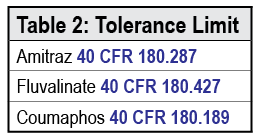 Following are the links to the lists of active ingredients and inert ingredients eligible for use in minimum risk products:
Following are the links to the lists of active ingredients and inert ingredients eligible for use in minimum risk products:
- The following link provides the list of active ingredients eligible for use in minimum risk exempt products: https://www.epa.gov/minimum-risk-pesticides/active-ingredients-eligible-minimum-risk-pesticide-products
- Inert ingredients eligible for use in exempt minimum risk pesticide products can be found in the 40 CFR, part 152.25, Table 2. The following link provides the list of the exempted inert ingredients: https://www.ecfr.gov/current/title-40/chapter-I/subchapter-E/part-152
What does it mean to have a tolerance or tolerance exemption under FFDCA?
Section 408 of FFDCA authorizes EPA to set tolerances, or maximum residue limits, for pesticide residues in foods. Unless a tolerance or exemption from the requirement of a tolerance is in effect, any pesticide residue in or on food is considered unsafe, and therefore adulterated. A food can also be considered adulterated if pesticide residues exceed the numerical limit of a tolerance. The sale or distribution of adulterated food is a violation of the FFDCA, and all adulterated foods are subject to regulatory and enforcement action by the government.
Does an exemption from the registration requirements under FIFRA automatically mean it is exempted under FFDCA from the requirements for a tolerance, and vice versa?
No. There are different requirements under FIFRA and FFDCA, and qualifying for an exemption under one does not automatically qualify for an exemption under the other.
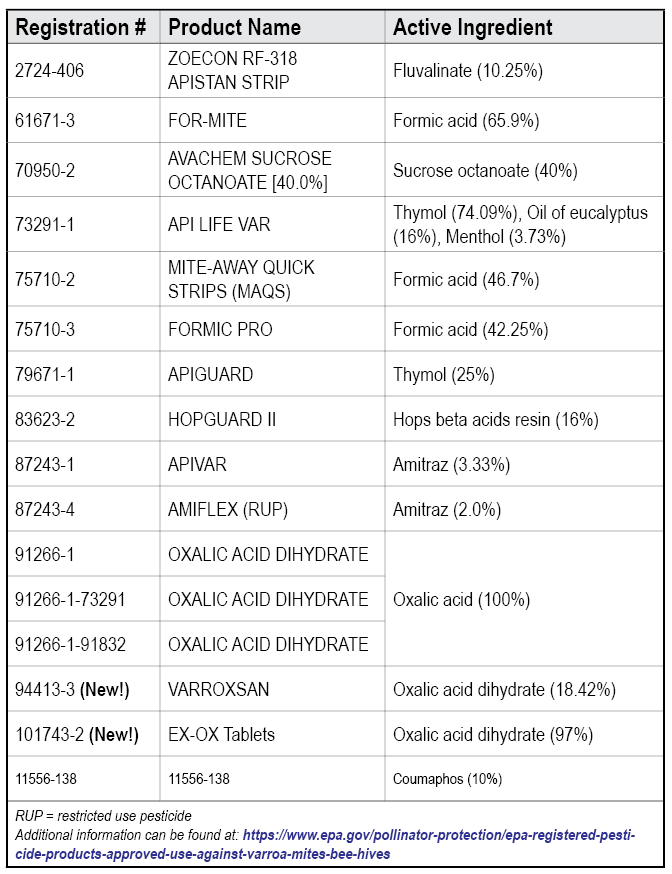
Table 1: EPA registered pesticide products approved for use against Varroa mites (Varroa destructor) in beehives
Are there pesticides registered under FIFRA that beekeepers can use to control varroa mites in their beehives?
Yes, Table 1 lists the only currently EPA registered pesticide products and their active ingredients that are registered for use to control varroa mites in beehives. Two recently registered varroacides are noted in bold. In registering these products, EPA has evaluated the potential risks to human health and the environment and determined that use of the products will not pose any unreasonable adverse effects when used according to the label instructions.
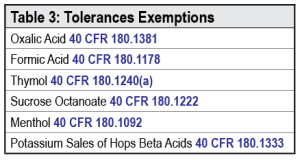 Are there tolerances or tolerance exemptions set under FFDCA that cover the residues of the pesticide products listed in Table 1?
Are there tolerances or tolerance exemptions set under FFDCA that cover the residues of the pesticide products listed in Table 1?
Yes. Above are the lists of tolerances (Table 2) and exemptions (Tables 3 and 4) that cover residues of the pesticide active ingredients contained in the currently EPA registered pesticide products listed in Table 1. Please note tolerance exemptions are based upon the assumption that the active ingredient is in registered pesticide and is used according to the label instructions. It is important to note that other ingredients (inerts) contained in the registered pesticide products must also be covered by an applicable tolerance or exemption under FFDCA.
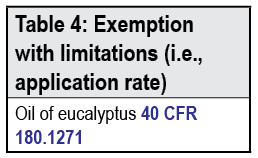
Is it a violation of FIFRA to use a registered pesticide in a manner that is not consistent with its label?
Yes, section 12(a)(2)(G) of FIFRA states that it shall be unlawful for any person to use any registered pesticide in a manner inconsistent with its labeling. The term “labeling” is defined under FIFRA to mean, “all labels and all other written, printed or graphic material” that accompanies a pesticide at any time or to which reference is made on the label or in literature accompanying the pesticide. All labeling directions must be followed when using an EPA-registered product.
Is it a violation of FIFRA for an individual to use unregistered products on their beehives (i.e., for their own personal use)?
EPA has been made aware that beekeepers are purchasing substances containing pesticide active ingredients (e.g., amitraz, oxalic acid, formic acid and thymol) that are not registered pesticides, then using the products for the pesticidal purpose of controlling varroa mites in bee colonies. There are EPA-registered formulations of these active ingredients in Table 1 approved for in-hive use.
The term “own personal use” does not appear in FIFRA, nor has EPA developed any special exceptions to FIFRA regulation for what might be considered “own personal use.” Personal use would not likely include activities that involve any operation in commerce such as selling or distribution of bees/colonies, pollination services or honey. An individual raising bees as a hobby and consuming themselves whatever honey is harvested might be considered “own personal use.” But as described previously, an individual beekeeper cannot sell or distribute (which includes transportation) any unregistered pesticide and cannot sell or distribute any adulterated honey or other edible beehive products.
It is a violation of FIFRA to use a registered pesticide in a manner that is inconsistent with its labeling. It is also a violation of FIFRA to sell or distribute an unregistered pesticide (unless, as discussed previously, that the pesticide is exempt from regulation under FIFRA). EPA considers any application of an unregistered pesticide for other than personal use (e.g., application of an unregistered pesticide to another person’s property) to be distribution of an unregistered pesticide and a violation of FIFRA.
Beekeepers using products that are not registered pesticides should be aware that EPA has not evaluated these products to determine if they pose potential harm to people or the environment, and any transportation or sale of that product with the intention to sell or distribute that product for pesticidal purposes would be a violation of FIFRA. As noted previously, EPA has already evaluated and registered pesticide products that can be safely used to control varroa mites in beehives, when used according to the label instructions. Moreover, if the unregistered product contains ingredients that have not been approved for use in food, or if there are any residues of the unregistered pesticidal substance left in the honey and no tolerance or tolerance exemption is in effect, then that honey may be considered adulterated, and sale or distribution of that food would be an unlawful act under the FFDCA.
Is it a violation of FIFRA or FFDCA to sell or distribute food derived from beehives (e.g., honey, comb, wax, propolis, royal jelly, pollen) harvested from beehives with unregistered products?
Pesticide applications to bee colonies may result in pesticide residues in or on food derived from beehives (e.g., honey, and/or honeycomb, wax, propolis, royal jelly, pollen). Off-the-shelf products that contain active ingredients but are not registered may contain “other ingredients” or may be combined with other substances for which tolerances or exemptions have not been established. Honey that contains residues of a formulation comprised of multiple substances (e.g., an active ingredient and other ingredients) where those residues are not covered by a tolerance or exemption from the requirement of a tolerance, would be considered adulterated. The sale and distribution of adulterated honey would be a violation of the FFDCA.
For example, although oxalic acid (40 CFR 180.1381), formic acid (40 CFR 180.1178), thymol (40 CFR 180.1240(a)) have the appropriate tolerance exemptions established for in-hive applications, unregistered products that contain these chemicals may also contain other ingredients or substances that lack a tolerance. Applying those products (alone or in combination) to a beehive may result in pesticide residues from those other ingredients in honey that are not covered by an existing tolerance or exemption under FFDCA. EPA believes it is likely that unregistered products contain other ingredients or substances for which tolerances have not been established under FFDCA.
Are there state pesticide laws that are different from FIFRA that may be applicable?
Yes, each state has its own pesticide statutes and regulations concerning the registration, sale or distribution, and use of pesticides within that state. Questions concerning state regulation are best answered by the appropriate state pesticide regulating agency.
Under FIFRA, states have broad authority to regulate pesticides. A state may regulate the sale, distribution or use of any unregistered or registered pesticide within the state. A state may register additional uses of a federally registered pesticide within the state to meet local needs unless EPA previously denied, disapproved or canceled such use. EPA recognizes and supports state efforts to protect human health and the environment through pesticide regulation and enforcement.
Each state also has its own statutes and regulations that govern apiary activities, plant pests and food production that may implicate pesticide use.
What other efforts is EPA engaged in to help beekeepers address the varroa mite issue?
Through its comprehensive registration process, EPA works to ensure that products that are proposed for pesticidal use by beekeepers against varroa mites and other hive pests meet the standards of FIFRA (no unreasonable adverse effects on the environment) and FFDCA (reasonable certainty of no harm from aggregate exposure to the pesticide residue).
EPA is committed to working closely with the beekeeping community to combat varroa mites, which are a serious pest that target honey bees. As a testament to that work, EPA recently registered two new pesticide products for the control of varroa mites. These products, when used in rotation with other varroa control measures, can help limit the development of mite resistance: https://www.epa.gov/pollinator-protection/epa-registered-pesticide-products-approved-use-against-varroa-mites-bee-hives.
EPA, in collaboration with USDA and its federal/Tribal/state partners, has been engaged in coordinated efforts to help address honey bee colony pests, which represent a nationwide threat. Efforts include prioritizing registration of pesticides, providing compliance support, conducting research on product efficacy, evaluating the factors associated with and mitigating bee kills, and developing models/tools for evaluating bees, integrated pest management approaches and other guidance. EPA encourages the beekeeping industry to work with manufacturers of pesticides that might be open to pursuing federal registration of products to control varroa mites and other emerging pests.
Original article:
Advisory on the Applicability FIFRA and FFDCA for Substances used to Control Varroa Mites in Beehives | US EPA




